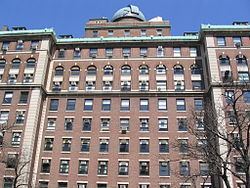Location New York, NY NRHP Reference # 66000550 Architecture firm McKim, Mead & White | Built 1925 - 1927 Designated NHL December 21, 1965 Added to NRHP 15 October 1966 | |
 | ||
Architectural style Renaissance inspired with colonial influence Similar Columbia University Low Mem, Philosophy Hall, Havemeyer Hall, St Paul's Chapel, Butler Library | ||
munimeter com pupin hall 538 west 120th street
Pupin Physics Laboratories, also known as Pupin Hall is home to the physics and astronomy departments of Columbia University in New York City and a National Historic Landmark. It was built in 1925-1927 to provide more space for the Physics Department which had originally been housed in Fayerweather Hall, and named for Serbian physicist Mihajlo Idvorski Pupin, who graduated with honors in 1883 at Columbia College, after his death in 1935. The building is located on the south side of 120th Street, just east of Broadway. It has been named a National Historic Landmark for its association with experiments relating to the splitting of the atom, achieved in connection with the later Manhattan Project.
Contents
- munimeter com pupin hall 538 west 120th street
- Map of Pupin Hall 704 pupin hall New York NY 10027 USA
- munimeter com columbiau pupin hall physics building
- Advances in research
- Features and layout quirks
- References
Map of Pupin Hall, 704 pupin hall, New York, NY 10027, USA
By 1931, the building which later became Pupin Hall was a leading research center. During this time Harold Urey (Nobel laureate in Chemistry) discovered deuterium and George B. Pegram was investigating the phenomena associated with the newly discovered neutron. In 1938, Enrico Fermi escaped fascist Italy after winning the Nobel prize for his work on induced radioactivity. In fact, he took his wife and children with him to Stockholm and immediately emigrated to New York. Shortly after arriving he began working at Columbia University with Dr. John Dunning. His work on nuclear fission, together with I. I. Rabi's work on atomic and molecular physics, ushered in a golden era of fundamental research at the university. One of the country's first cyclotrons was built in the basement of Pupin Hall by John R. Dunning, where it remained until 2007. The building's historic significance was secured with the first splitting of a uranium atom in the United States, which was achieved by Enrico Fermi in Pupin Hall on January 25, 1939, just 10 days after the world's first such successful experiment, carried out in Copenhagen, Denmark.
Pupin Hall is named after Mihajlo Idvorski Pupin (also known as Michael I. Pupin), a Serbian-American scientist and graduate of Columbia. Returning to the university's engineering school as a faculty member, he played a key role in establishing the department of electrical engineering. Pupin was also a brilliant inventor, developing methods for rapid x-ray photography and the "Pupin coil," a device for increasing the range of long-distance telephones. After his death in 1935, the university trustees named the newly constructed physics building the "Pupin Physics Laboratories" in his honor.
The building was declared a National Historic Landmark in 1965. In 2009 the American Physical Society named Pupin Hall a historic site and honored Isidor Isaac Rabi for his work in the field of magnetic resonance.
munimeter com columbiau pupin hall physics building
Advances in research
The building is a landmark due to the advances in nuclear research made there during the Manhattan Project to develop the first nuclear weapon. It is connected to the university tunnels, from which one can occasionally access the Manhattan Project's leftover cyclotron and other historic research facilities. Sadly, many of these have been sealed off since the 1980s, when Ken Hechtman wrought havoc with nuclear materials he stole from Pupin's basement.
Other discoveries and breakthroughs achieved in Pupin include:
Features and layout quirks
The current entrance to Pupin is on the 5th floor from the plaza above Dodge Physical Fitness Center. This means that many of the seminar rooms in Pupin on floors 2-4, while above ground, are below campus level and, therefore, windowless. The original entryway was on the first floor from the Grove, but got blocked by the construction of Dodge in the 1960s. The entryway smells like chlorine because Uris Pool has an exit stairway leading into Pupin's entry.
The Rutherfurd Observatory is on top of Pupin, which is convenient for the Astronomy Department professors who also work in Pupin. However, the night sky in New York is sometimes too bright for it to be used. Instead, astronomical observers may opt to use the 24-inch telescope at Harriman Observatory, built by Competition Associates. Nevertheless, the Astronomy Department hosts bi-monthly Public Observing Nights, and serves the Tri-State area in hosting people interested in observing with an optical telescope.
